Mi Quang: Central Vietnam Must-Eat Noodle Dish
I vividly remember the first time I tasted Mì Quảng( Quang noodle), though it wasn’t in the heartland of Quang Nam Province where this iconic Vietnamese dish originates. Instead, it was in the cozy confines of my family’s kitchen, where my dad unveiled his own rendition of this Central Vietnam delicacy. As I savored the vibrant flavors of her homemade Mì Quảng, I couldn’t help but feel that I was experiencing something special, something that captured the essence of Central Vietnam’s culinary heritage. And that’s what motivated me to visit the homeland of Mì Quảng, and enjoy the original flavor.
What is Mì Quảng?
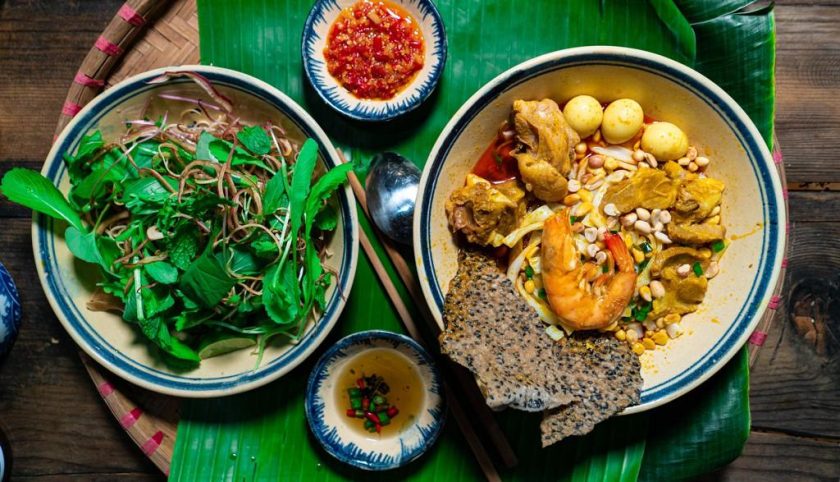
Mi Quang’s roots trace back through the annals of Central Vietnamese history. Mi Quang, also known as “Quang noodles,” is a delicious noodle dish that comes from Quang Nam province in central Vietnam.
Mi Quang, a quintessential dish representing Quang Nam, reflects the resourcefulness and ingenuity of the locals. In the bygone days, this dish graced the tables of peasants and farmers in the countryside, where ingredients were gleaned from what was at hand – rice, water, vegetables, herbs, and meat.
These simple components underwent a remarkable transformation. Rice was meticulously ground into flour, blended with water and turmeric, yielding the characteristic yellow noodles. The broth, rich in flavor, was born from the infusion of bones and spices. Verdant vegetables and fragrant herbs were plucked fresh from fields and gardens. The choice of meat, whether chicken, pork, shrimp, or fish, depended on the season’s offerings.
When plated, Mi Quang arrived with a modest serving of broth, accompanied by crushed peanuts and toasted rice crackers, imparting a delightful crunch to every bite.
The Ingredients and Variations of Mi Quang
What makes Mi Quang unique and different from other Vietnamese noodle dishes, in my opinion, is the combination of its ingredients and variations. Mi Quang consists of four main components: noodles, broth, meat, and toppings. Each component has its own characteristics and variations, which can be customized according to personal preferences and tastes.
Noodles
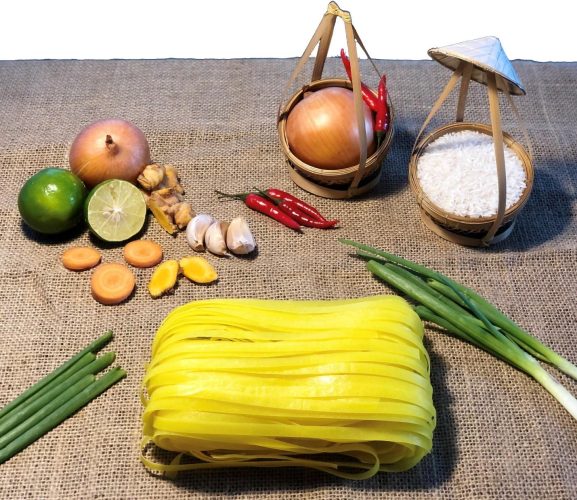
The noodles are crucial to Mi Quang, giving the dish its name and distinctive character. These special noodles are made from rice flour, water, and turmeric. They have a lovely yellow color and a slightly chewy texture.
Usually, they’re nice and flat, about 5 to 10 mm thick. But hey, some people like them thicker or thinner, so it’s all up to personal preference. To make them just right, you boil them until they’re soft but not mushy. Then you give them a quick rinse with cold water to keep them from sticking together.
Broth

You know what else makes Mi Quang super delicious? The broth! This is where the magic happens. It’s made by simmering some bones, like pork or chicken, with water and spices. We’re talking about stuff like salt, sugar, fish sauce, black pepper, shallot, garlic, and annatto seeds. All those goodies give the broth a reddish color and a bold taste. You only need a bit of the broth to partially cover the noodles and veggies. Right before serving, you pour it over the noodles to keep everything yummy, moist, and warm.
Meat
Of course, we can’t forget about the meat! Meat adds protein and texture to Mi Quang, being the third essential element. You can use chicken, pork, shrimp, fish, or beef—whatever floats your boat. The meat gets marinated with delicious spices such as salt, sugar, fish sauce, black pepper, shallot, garlic, and lemongrass.
After that, you can cook it by boiling, grilling, frying, or roasting until it’s super tender and juicy. Then, slice or shred it and place it on top of those beautiful noodles.
Toppings

Now, it’s time to add some finishing touches to our Mi Quan.
- Fresh herbs like basil, cilantro, scallions, Vietnamese coriander, sliced banana flower, and lettuce. They bring a refreshing aroma and give you vitamins and minerals.
- Don’t forget the crushed peanuts and toasted sesame rice crackers, also known as banh trang me. They add a satisfying crunch, along with healthy fats and protein.
- For a little extra something, how about hard-boiled quail eggs, steamed pork sausage, or shredded pork rinds?
- And if you want some tanginess and spiciness, squeeze in some lime juice and toss in some fresh chili peppers. You’ll get a zesty kick, plus a boost of vitamin C and capsaicin.
Yum! Mi Quang is all about mixing these incredible elements together to create a mouthwatering bowl. Give it a try and enjoy the explosion of flavors!
The Best Places to Eat Mi Quang in Central Vietnam
I’ve had the chance to explore some of the most places that serve Mi Quang, and I want to share them with you.
Mi Quang Ong Hai Hoi An
- Location: 6A Truong Minh Luong, Hoi An City
- Opening Hours: 6 am – 10 pm
- Price range: 15,000 – 40,000 VND
Mi Quang Ba Mua
- Location: 95 A Nguyen Tri Phuong
- Opening Hours: 06:00 – 23:00
- Price range: 20.000 VND – 50.000 VND
Mi Quang Ba Vi
- Location: 166 Nguyen Trai Street, Hoi An City
- Opening Hours: 7:00 – 21:00
- Price range: 30,000 VND- 60,000 VND
So, the next time you find yourself in Central Vietnam, make sure to seek out a bowl of Mi Quang, and let your taste buds embark on a journey they won’t soon forget. Trust me, these places will take your Mi Quang experience to a whole new level. I hope you enjoy your culinary adventure in central Vietnam as much as I did!
Relate blog
Relate blog
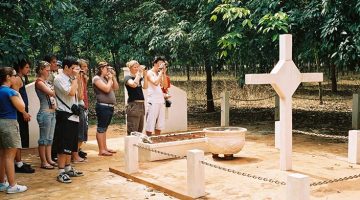
Situated in the serene rural area of Ba Ria-Vung Tau province, the Long Tan Cross serves as a poignant reminder…
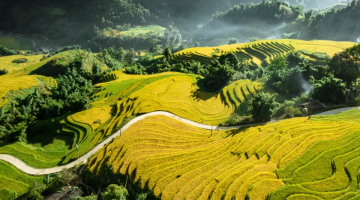
Located in the Ta Phin commune, Giang Ta Chai is regarded as one of Sapa’s most picturesque villages. Situated at…
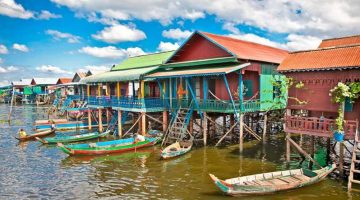
The Kampong Khleang Floating Village, tucked away in the center of Siem Reap Province, is a monument to the rich…

